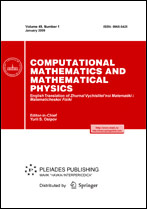|
This article is cited in 5 scientific papers (total in 5 papers)
General numerical methods
Iterative preconditioned methods in Krylov spaces: trends of the 21st Century
V. P. Il'inab
a Institute of Computational Mathematics and Mathematical Geophysics, Siberian Branch, Russian Academy of Sciences, 630090, Novosibirsk, Russia
b Novosibirsk State Technical University, 630073, Novosibirsk, Russia
Abstract:
A analytic review of major problems and new mathematical and technological discoveries in methods for solving SLAEs is given. This stage of mathematical modeling is a bottleneck because the amount of the required computational resources grows nonlinearly with the increasing number of degrees of freedom of the problem. It is important that the efficiency and performance of computational methods and technologies significantly depend on how well the specific features of the class of application problems–electromagnetism, fluid dynamics, elasticity and plasticity, multiphase filtering, heat and mass transfer, etc. are taken into account. The development of Krylov iterative processes is mainly intended for the construction of two-level algorithms with various orthogonal, projective, variational, and spectral properties, including not only polynomial but also rational and harmonic approximation techniques. Additional acceleration of such algorithms is achieved on the basis of deflation and augmenting approaches using various systems of basis vectors. The goal of intensive studies is to construct efficient preconditioning operators on the basis of various principles: new multigrid schemes and parallel domain decomposition methods, multipreconditioning, nested and alternate triangular factorizations, low-rank and other algorithms for approximating inverse matrices, etc. High-performance and scalable parallelization are based on hybrid programming using internode message passing, multithreaded computations, vectorization, and graphics processing units (GPUs). Modern trends in mathematical methods and software are aimed at the creation of an integrated environment designed for a long lifecycle and massive innovations in important applications.
Key words:
sparse SLAE, preconditioning, iterative methods, Krylov subspaces, symmetric and asymmetric matrices, decomposition algorithms, multigrid approaches, approximate factorization.
Received: 11.02.2020
Revised: 16.03.2021
Accepted: 07.07.2021
Citation:
V. P. Il'in, “Iterative preconditioned methods in Krylov spaces: trends of the 21st Century”, Zh. Vychisl. Mat. Mat. Fiz., 61:11 (2021), 1786–1813; Comput. Math. Math. Phys., 61:11 (2021), 1750–1775
Linking options:
https://www.mathnet.ru/eng/zvmmf11314 https://www.mathnet.ru/eng/zvmmf/v61/i11/p1786
|


|





 Contact us:
Contact us: Terms of Use
Terms of Use
 Registration to the website
Registration to the website Logotypes
Logotypes








 Citation in format
Citation in format 
